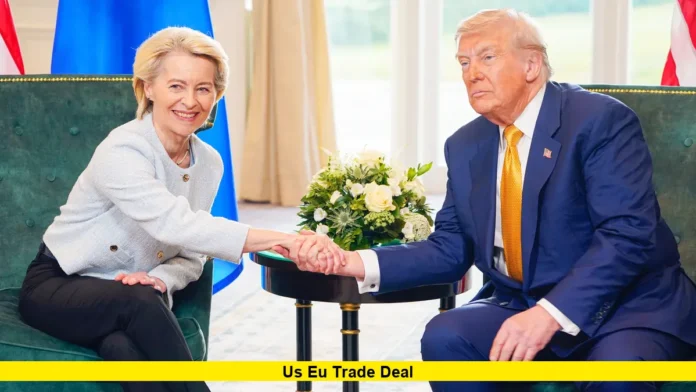The phrase “US and EU reach a trade deal” is dominating headlines as of July 28, 2025, after months of intense negotiations. In a historic announcement from Scotland, US President Donald Trump and European Commission President Ursula von der Leyen confirmed they’ve ended months of tension by striking the largest economic agreement either side has ever brokered. This breakthrough comes days before a looming US tariff deadline, calming global markets and offering relief to businesses on both sides of the Atlantic.
The new framework imposes a blanket 15% tariff on most European Union exports to the United States, halving the 30% rate initially threatened by the US president. In return, the EU will open markets for select American goods at zero tariffs, invest $600 billion directly into the US economy, and pledge $750 billion over three years for US energy imports—including liquefied natural gas, oil, and nuclear fuel. According to both leaders, this deal will “bring stability and predictability,” a crucial assurance for industries still reeling from the uncertainty of past months.
Key Details of the Trade Deal
- Tariff Overview: Most EU products entering the US now face a 15% tariff, up from the previous 10% for most items but significantly down from the proposed 30%. High tariffs on steel and aluminum (50%) remain intact, though a new quota system may apply to metals.
- Zero-for-Zero Tariffs: Aircraft, plane parts, some chemicals, generic drugs, semiconductor equipment, certain farm goods, and critical raw materials are exempt from tariffs on both sides, marking a major win for high-tech and aerospace sectors.
- Massive Investments: Europe’s commitment includes $600 billion in new investment across US industries, alongside unprecedented energy purchases that could shift EU reliance away from Russian supplies.
- Automotive Impact: EU carmakers, especially Germany’s auto giants like Volkswagen, Mercedes, and BMW, see tariffs halved from 27.5% to 15%. While this offers some relief, the new structure will still cost manufacturers billions a year and continue to fuel debate within the EU about the fairness of the agreement.
- Approval Process: All 27 EU member states must ratify the deal, and early reactions hint at challenges ahead. While the consensus is that the EU averted a worse outcome, leaders in France and Hungary have voiced frustration, fearing lost economic leverage and uneven sectoral impacts.
- Market Response: Global stock markets, especially in Europe and Asia, climbed on the news, while oil prices rose in anticipation of the EU’s energy purchases.
Table: Headline Numbers from the Deal
| Feature | Previous Rate | New Rate/Value | Notes |
|---|---|---|---|
| Tariff on Most EU Goods | 10%-25% | 15% | Except steel/aluminum (still 50%) |
| Steel & Aluminum | 25%-50% | 50% | With quota system for lower tariffs below set thresholds |
| Zero Tariff Sectors | Aircraft, select chemicals, generics, farm goods | 0% | Applies on both sides |
| EU Investment in US | Varied | $600B | To be distributed over several years |
| EU Energy Purchases | Under $200B/year | $750B over 3 years | Mix of LNG, oil, nuclear fuel |
Winners and Losers
- Winners:
- US government (billions in new tariff revenue)
- Some US exporters (zero-tariff access in exempt sectors)
- Global markets (stability, positive investor sentiment)
- Losers:
Reactions and Next Steps
The US and EU both call the agreement a triumph, with President Trump touting it as “the biggest of all the deals”. Von der Leyen highlighted the deal’s role in securing energy and economic stability, but also acknowledged tough negotiations and necessary compromise. Some leaders, notably in France and Hungary, fear the agreement could trigger internal fractures within the EU bloc.
Despite the positive headlines and averted trade war, skeptics warn much remains unresolved. Specific product lists, especially for agriculture and luxury goods, are still being finalized. Approval by all EU member states is necessary, which could introduce new political hurdles. Nonetheless, after months of uncertainty, today’s deal marks a dramatic reset for transatlantic economic ties.
What are your thoughts on the new US-EU trade deal? Share your opinions in the comments and stay tuned for more updates on this developing story!
